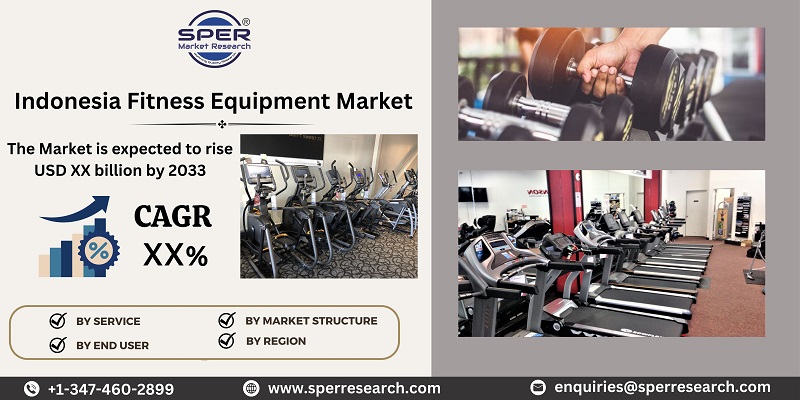
Indonesia Fitness Equipment Market Growth, Size, Trends, Revenue, Challenges and Future Scope
Indonesia Fitness Equipment Market Size- By Service, By End User, By Market Structure- Regional Outlook, Competitive Strategies and Segment Forecast to 2033
| Published: Jul-2023 | Report ID: MACH2336 | Pages: 1 - 102 | Formats*: |
| Category : Equipment and Machinery | |||
- Market Trends: Increasing Health and Fitness Awareness: As individuals become more health-conscious and aware of the benefits of regular exercise, the demand for fitness equipment in Indonesia is increasing. Concerns about sedentary lifestyles, obesity, and other health conditions have increased interest in home fitness solutions and gym memberships, boosting demand for exercise equipment.
- Growing Middle-Class Population: Indonesia has experienced tremendous economic growth as well as a growing middle-class population. As disposable incomes rise, more people may afford to buy fitness equipment for their homes or join gyms, boosting up market demand.


| Report Metric | Details |
| Market size available for years | 2019-2033 |
| Base year considered | 2022 |
| Forecast period | 2023-2033 |
| Segments covered | By Service, By End User, By Market Structure |
| Regions covered | Northern Region, Eastern Region, Western Region, Southern Region. |
| Companies Covered | Brunswick Corporation, Amer Sports, Cybex International, Primafit, Solution Fitness, Gold's Gym, Celebrity Fitness, Fitness First, 20Fit, RockStar Gym, Osbond Gym. |
- Fitness Enthusiasts
- Gym and Fitness Centers
- Sports Teams and Athletes
- Home users
| By Service |
|
| By End User |
|
| By Market Structure |
|
- Indonesia Fitness Equipment Market Size (FY’2023-FY’2033)
- Overview of Indonesia Fitness Equipment Market
- Segmentation of Indonesia Fitness Equipment Market By Service (Gym, Yoga, Pilates, Martial Arts, Swimming)
- Segmentation of Indonesia Fitness Equipment Market By End User (Fitness Clubs and Gyms, Corporate Wellness Programs, Educational Institutions, Individual Consumers)
- Segmentation of Indonesia Fitness Equipment Market By Market Structure (Organized, Unorganized)
- Statistical Snap of Indonesia Fitness Equipment Market
- Expansion Analysis of Indonesia Fitness Equipment Market
- Problems and Obstacles in Indonesia Fitness Equipment Market
- Competitive Landscape in the Indonesia Fitness Equipment Market
- Effects of COVID-19 and demonetization on Indonesia Fitness Equipment Market
- Details on Current Investment in Indonesia Fitness Equipment Market
- Competitive Landscape of Indonesia Fitness Equipment Market
- Prominent Players in the Indonesia Fitness Equipment Market
- SWOT Analysis of Indonesia Fitness Equipment Market
- Indonesia Fitness Equipment Market Future Outlook and Projections (FY’2023-FY’2033)
- Recommendations from Analyst
1.1. Scope of the report1.2. Market segment analysis
2.1. Research data source2.1.1. Secondary Data2.1.2. Primary Data2.1.3. SPER’s internal database2.1.4. Premium insight from KOL’s2.2. Market size estimation2.2.1. Top-down and Bottom-up approach2.3. Data triangulation
4.1. Driver, Restraint, Opportunity and Challenges analysis4.1.1. Drivers4.1.2. Restraints4.1.3. Opportunities4.1.4. Challenges4.2. COVID-19 Impacts of the Indonesia Fitness Equipment Market
5.1. SWOT Analysis5.1.1. Strengths5.1.2. Weaknesses5.1.3. Opportunities5.1.4. Threats5.2. PESTEL Analysis5.2.1. Political Landscape5.2.2. Economic Landscape5.2.3. Social Landscape5.2.4. Technological Landscape5.2.5. Environmental Landscape5.2.6. Legal Landscape5.3. PORTER’s Five Forces5.3.1. Bargaining power of suppliers5.3.2. Bargaining power of buyers5.3.3. Threat of Substitute5.3.4. Threat of new entrant5.3.5. Competitive rivalry5.4. Heat Map Analysis
6.1. Indonesia Fitness Equipment Market Manufacturing Base Distribution, Sales Area, Product Type6.2. Mergers & Acquisitions, Partnerships, Product Launch, and Collaboration in Indonesia Fitness Equipment Market
7.1. Indonesia Fitness Equipment Market Value Share and Forecast, By Service, 2023-20337.2. Gym7.3. Martial Arts7.4. Pilates7.5. Swimming7.6. Yoga
8.1. Indonesia Fitness Equipment Market Value Share and Forecast, By End User, 2023-20338.2. Corporate Wellness Programs8.3. Educational Institutions8.4. Fitness Clubs and Gyms8.5. Individual Consumers
9.1. Indonesia Fitness Equipment Market Value Share and Forecast, By Market Structure, 2023-20339.2. Organized9.3. Unorganized
10.1. Indonesia Fitness Equipment Market Size and Market Share
11.1. Indonesia Fitness Equipment Market Size and Market Share By Service (2019-2026)11.2. Indonesia Fitness Equipment Market Size and Market Share By Service (2027-2033)
12.1. Indonesia Fitness Equipment Market Size and Market Share By End User (2019-2026)12.2. Indonesia Fitness Equipment Market Size and Market Share By End User (2027-2033)
13.1. Indonesia Fitness Equipment Market Size and Market Share By Market Structure (2019-2026)13.2. Indonesia Fitness Equipment Market Size and Market Share By Market Structure (2027-2033)
14.1. Indonesia Fitness Equipment Market Size and Market Share By Region (2019-2026)14.2. Indonesia Fitness Equipment Market Size and Market Share By Region (2027-2033)14.3. Northern Region14.4. Eastern Region14.5. Western Region14.6. Southern Region
15.1. Azzalea Mitra Sukses15.1.1. Company details15.1.2. Financial outlook15.1.3. Product summary15.1.4. Recent developments15.2. Daxa Sumber Abadi15.2.1. Company details15.2.2. Financial outlook15.2.3. Product summary15.2.4. Recent developments15.3. Fitnessindo Sarana Mitra15.3.1. Company details15.3.2. Financial outlook15.3.3. Product summary15.3.4. Recent developments15.4. Galaxy Fitness Indonesia15.4.1. Company details15.4.2. Financial outlook15.4.3. Product summary15.4.4. Recent developments15.5. Precor Indonesia15.5.1. Company details15.5.2. Financial outlook15.5.3. Product summary15.5.4. Recent developments15.6. Satya Lencana Mitra Sejahtera15.6.1. Company details15.6.2. Financial outlook15.6.3. Product summary15.6.4. Recent developments15.7. Others
SPER Market Research’s methodology uses great emphasis on primary research to ensure that the market intelligence insights are up to date, reliable and accurate. Primary interviews are done with players involved in each phase of a supply chain to analyze the market forecasting. The secondary research method is used to help you fully understand how the future markets and the spending patterns look likes.
The report is based on in-depth qualitative and quantitative analysis of the Product Market. The quantitative analysis involves the application of various projection and sampling techniques. The qualitative analysis involves primary interviews, surveys, and vendor briefings. The data gathered as a result of these processes are validated through experts opinion. Our research methodology entails an ideal mixture of primary and secondary initiatives.



Frequently Asked Questions About This Report
PLACE AN ORDER
Year End Discount
Sample Report
Pre-Purchase Inquiry
NEED CUSTOMIZATION?
Request CustomizationCALL OR EMAIL US
100% Secure Payment






Related Reports
Our Global Clients
Our data-driven insights have influenced the strategy of 200+ reputed companies across the globe.




















